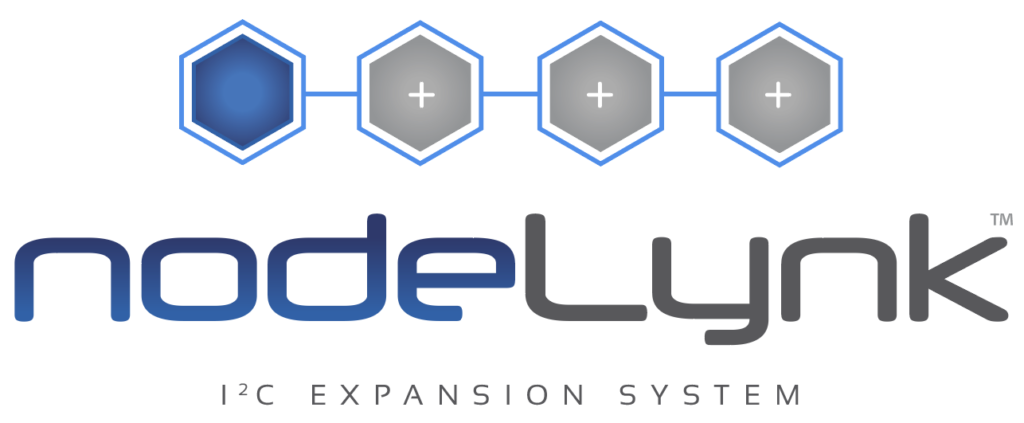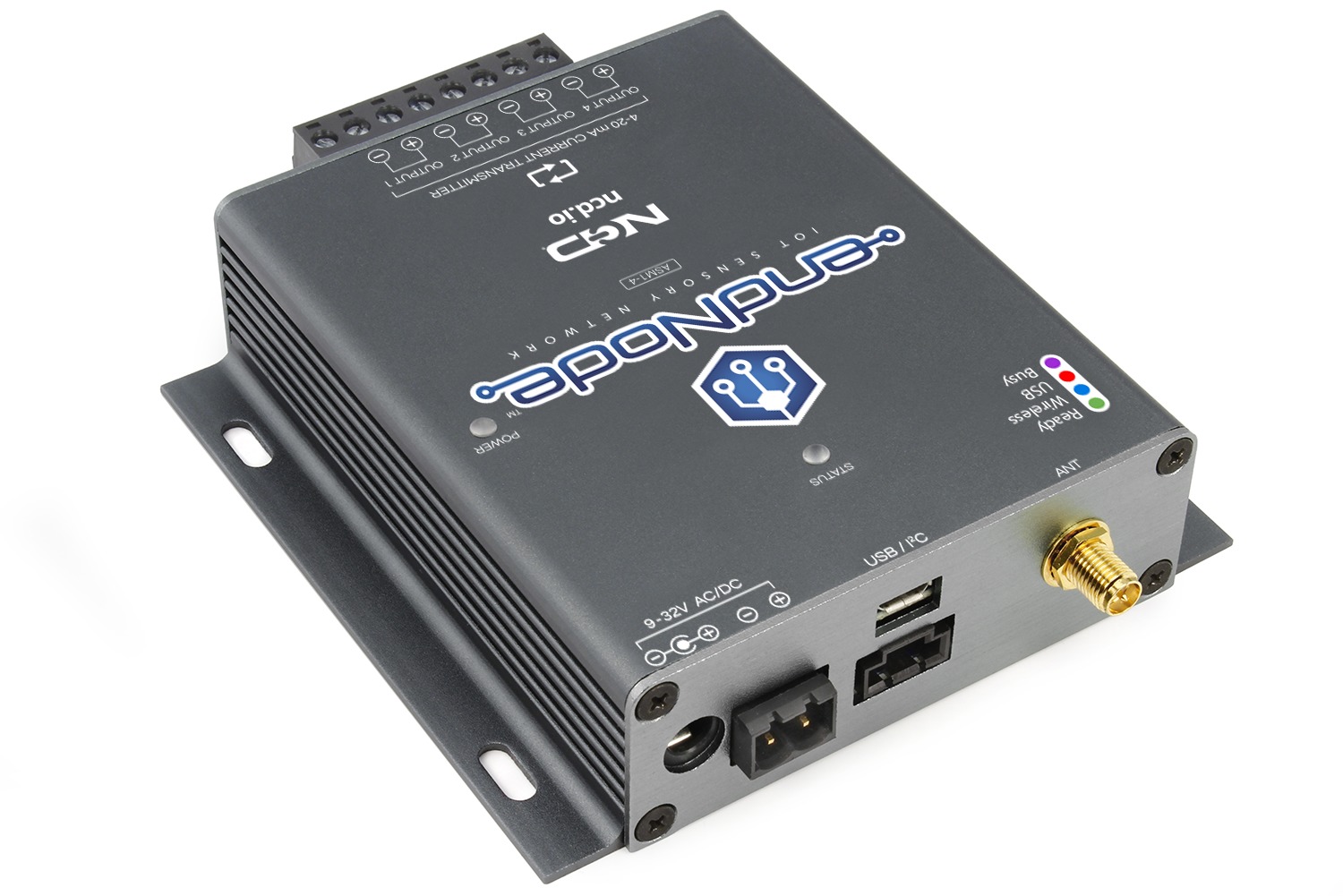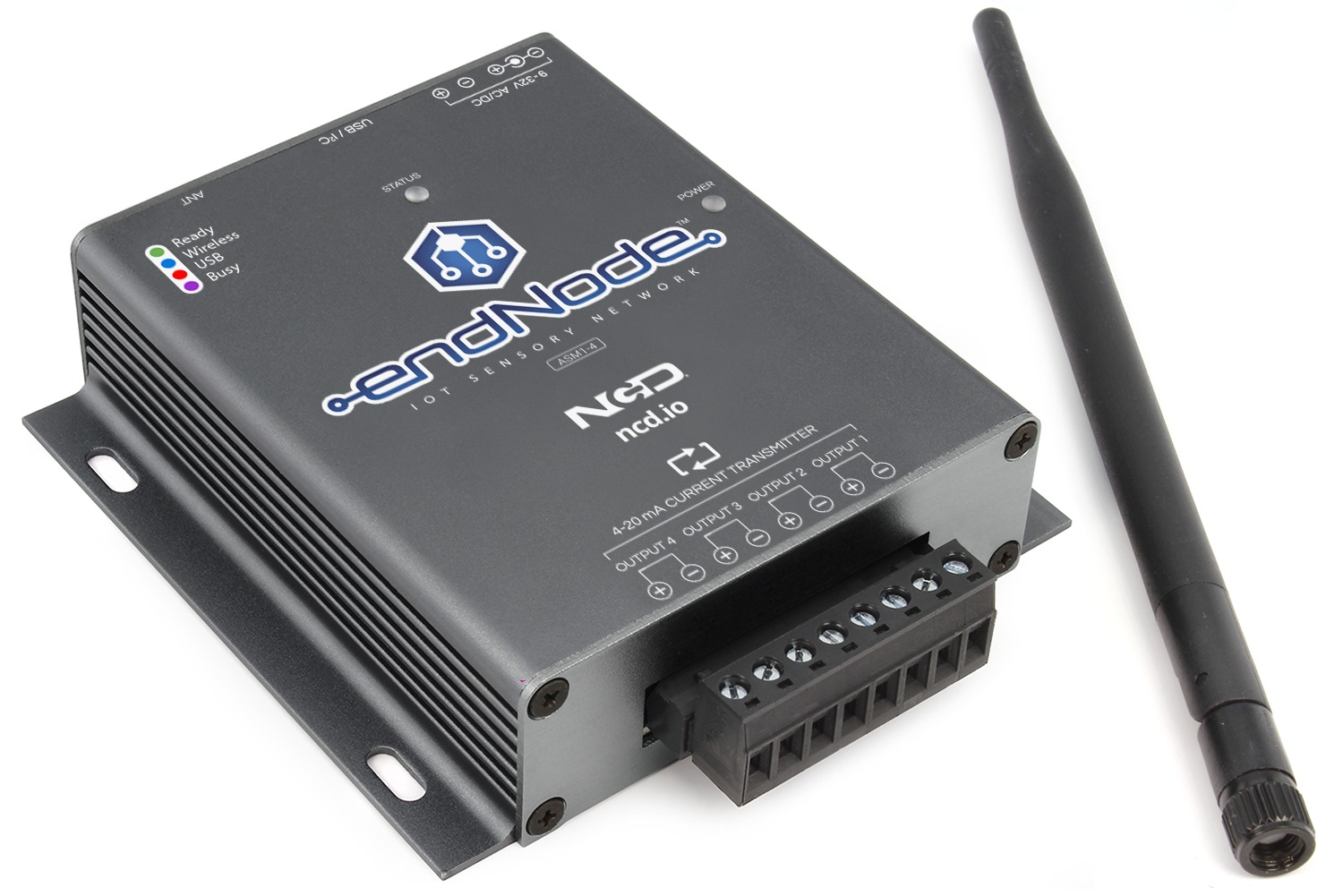Wireless 4-20mA Output Current Transmitter 4-Channel USB endNode
Highlights
- 4-Channel 14-Bit Wireless 4-20mA DC Current Loop Output endNode with USB
- Isolated 4-20mA Current Loop Outputs with a 0-25mA Programmable Range
- Isolated Outputs Allow a Single External Supply to Control All 4-20mA Devices
- Internal Isolated I2C Communications Bus to Reduce Noise Contamination
- Long Range Wireless Communications with 128-Bit AES Encryption
- USB Communications Interface with Virtual COM Port Access
- Dual 9-32V DC Power Interface with Power and RGB Status LEDs
- Long Range Wireless Communications up to 2 Miles at 900MHz
- 900MHz, 868MHz and 2.4GHz Wireless Options with Antenna
- Pluggable Connectors for Wireless 4-20mA Current Loop Output and Power
- Based on NCD endNode Wireless I²C Architecture
- I2C Expansion Port for Limitless Expansion Capabilities
- Expandable to Control NCD I2C Devices and Sensors
- ProXR Enterprise Command Set for I2C Relay Expansions
Wireless 4-20mA Output Current Loop Transmitter
Introducing the world’s most powerful Wireless 4-20mA Output Current Loop Transmitter. The ASM1-4 makes it easy to control industrial 4-20mA devices with an incredible 2-Mile wireless communication range using 128-Bit AES Encryption. The ASM1-4 is capable of sending up to 4 isolated channels of 4-20mA DC Current to control a wide variety of devices equipped with a 4-20mA input. With nearly a 14-Bit resolution, each output is controlled using a integer value between 0 and 15,525 providing a programmable DC output current output range of 0 to 25mA per channel. Control Dampers, Sprinklers, Flow control Valves, Actuators, Solenoids, and Motor Drives. The 4-20mA Output of the ASM1-4 are compatible with 4-20mA digital panel meters and PLCs that accept a 4-20mA DC current input. Use several ASM1-4 endNodes and talk to each endNode using secure wireless communications. Control wireless 4-20mA outputs on the factory floor, as we have tested this wireless technology in factories in excess of 1 mile indoor line-of-sight with heavy industrial machines operating. This communications technology is rock solid in electrically noisy environments. Control wireless 4-20mA inputs in industrial buildings, as this wireless technology has the best wireless penetration through walls currently available.
The ASM1-4 includes a powerful command set for controlling each 4-20mA output individually or all four outputs simultaneously. When power is lost, the 4-20mA output state may be configured to turn off, return to the last known state, or set all outputs to a predefined startup state. The ASM1-4 command set also supports reading the state of the each output or read the state of all outputs simultaneously, so your software is always synchronized with the 4-20mA output currents.
Wireless Targeting and Mesh Communications
Each endNode controller includes a unique serial number. This serial number is used to target the remote endNode controller with a 4-Channel 4-20mA output control request. Control each endNode up to six times per second using wireless communications. Use a single computer to target several endNode devices in the area or use multiple computers to talk to multiple wireless endNodes. endNodes form a wireless mesh to extend communication range beyond the typical 2-Mile line-of-sight range by hopping data between devices to reach the intended target device. All endNode devices are secured using 128-Bit AES Encryption. NCD endNode devices may also be used to repeat data from NCD Enterprise wireless sensors, as they act as a mesh network of repeaters to help sensors extend the wireless range. All endNode devices are available in 900MHz, 868MHz and 2.4GHz versions, but may have a reduced wireless range when using 868MHz and 2.4GHz options.
Definition of 4-20mA Current Loop Outputs
Current Loop Outputs are best defined as DC outputs that vary the current load from 4 to 20mA. Each 4-20mA output requires a voltage source, which is based on your specific control application. Since each 4-20mA output is isolated, a single supply may be used for all 4-20mA output channels. While the term 4-20mA is commonly used, the actual output range of NCD 4-20mA output is 0 to 25mA. Current below 4mA are typically considered open loop by most receiving devices, which typically identifies as a wiring fault.
USB 4-20mA Current Loop Outputs
All endNode devices are equipped with a USB port. Use the USB interface to control 4-20mA current loop output channels. USB is also used for advanced configuration using our Windows 10 Alpha Station Software. endNode devices mount as a Virtual COM Port on your PC to simplify communications. endNode devices are hardware compatible with Mac and Linux computers, we can assist you in using endNode devices on these platforms, but specific software has not yet been developed. Cross-platform Node-Red support for endNode devices is planned.

Expand endNodes™ using nodeLynk™
endNode devices are expandable to add additional hardware for sensing and control capabilities using nodeLynk expansions.
What is nodeLynk?
Chain expansion devices using nodeLynk. Connect a wide variety of accessories to expand the capabilities of a nodeLynk compatible controller. Use nodeLynk to add Relay Controllers, Sensors, PWM Drivers, Displays, and a wide variety of 4-20mA, 0-10V ADCs and DACs, as well as a wide array of TTL & Isolated GPIO devices. All nodeLynk devices use I2C communications to chain devices together. nodeLynk is an easy way to expand functionality without soldering. nodeLynk allows expansion in seconds so you can focus on your software and firmware development.

Wireless I2C Communications
endNode devices include a I2C expansion port, providing many wireless I2C expansion options. NCD endNode devices convert data from Wireless and USB Communications into I2C Communications using our custom conversion processor. Since I2C communications is the foundation technology for all sensors manufactured today, NCD endNode controllers are capable of communicating to all I2C devices ever manufactured today and well into the future, giving endNode controllers limitless expansion possibilities. I2C plays a major role in IoT applications, as it’s not possible to talk to most sensors without some form of I2C conversion along the way. Because endNode controllers are a data conversion technology, firmware upgrades will not be necessary to add support for future I2C expansions and devices. Here’s a current list of all the I2C devices that will plug into endNode controllers.
ProXR Enterprise Command Set
Use the I2C Expansion port to plug in relays and try out our ProXR Enterprise command set. Turn relays on or off, Trigger relay timers, pulse relays, control relays in sequences, toggle relays, and much more. The ProXR Enterprise command set provides users with simple commands that are converted to low-level I2C commands for relay control applications. Integrated FRAM memory retains relay state when power is removed, and recovers relay state on power-up. Check our our line of I2C Relay controllers compatible with endNode.
endNode Power Requirements
endNode devices were designed to operate continuously from a 9-32V external power supply. A +12VDC international power supply is included. A two-position pluggable terminal block is also included for direct wired applications. A red power LED indicates power status while a RGB LED is used to indicate processor status.
Wireless Communications with endNodes
Make the most of your endNode devices by communicating using wireless communications. endNodes support the use of multiple modems simultaneously, so many computers, servers, and embedded devices can access endNodes. endNodes support targeting via the serial number. Simply package up the serial number and the command together into a data frame using the NCD API Calculator and your command will be executed by the endNode controller. Then endNode will report back ONLY to the modem that initiated communications. In this way, endNodes are capable of services many computers as long as the wireless traffic does not become excessively saturated. Below you will find many popular modem options designed to speak to NCD endNode devices using the communication technologies you are most comfortable working with.

Mega Modem Communications with endNode Devices
The Mega Modem allows communications with endNode controllers using up to 4 technologies. Mega Modems include a USB port for direct access to remote endNodes via a USB port. This is essentially the same as having a USB Modem (shown below). In addition to USB, a wireless Bluetooth link to the Mega Modem allows access to remote endNode devices. Bluetooth communications supports Virtual COM Port over Bluetooth for easy integration. In addition to Bluetooth, WiFi TCP is also supported, allowing communications to endNodes by simply opening the IP Address and Port and sending/receiving TCP data to the endNode controller.
We saved the best for last, as the Mega Modem also supports MQTT over WiFi. Using MQTT communications, the Mega Modem can subscribe to “Transmit” topic and publish to a “Receive” topic using most MQTT brokers. Raw data to and from the MQTT broker is communicated directly to the endNode. This allows tremendous control of endNode devices and expansions over MQTT. We advise the usage of the MQTT features by experienced users, as this will require some deep understanding of how to move data. For those eager to learn, we may be able to help if you have some foundation knowledge of MQTT.
USB Communications with endNode Devices
USB Communications still remains one of the most popular ways to talk to remote endNode devices. Simply open a Virtual COM Port over USB and start communicating with endNode devices. USB modems are capable of talking to many endNode devices, as each communication packet is designed to target a specific endNode controller. The responses from endNodes will be reflected back to the USB Modem that initiated communications. The USB Modem operates at 115.2K Baud.
Ethernet Communications with endNode Devices
Ethernet communications with endNode devices is very popular with our customers. Simply open the IP Address and TCP port of the Ethernet Modem and start sending and receiving TCP data. Multiple Ethernet modems may be used to communicate with endNode devices, as data from the modem will target a specific endNode. Similarly, endNodes will reply only to the requester of data ONLY.
RS-485 Communication with endNode Devices
RS-485 communications remains a favorite for our industrial clients. Using RS-485 is relatively easy to work with, simply communicate with the modem at 9600 baud and the modem will target the user selected endNode (as part of the communications packet). Data will be reflected from the endNode back to the RS-485 modem and delivered to the RS-485 port. Like all modems, the communications distance is up to 2 Miles line of sight using the included antennas.
endNodes and Visual Studio
We Developed Alpha Station using Visual Studio to demonstrate the use of endNodes. Alpha Station allows you to view and set basic configuration settings of remote sensors up to 2 miles away. Alpha Station supports our Wireless USB Modem, our Mega Modem, and our Wireless Ethernet Modem. The source code and run-time application is available for download on our web site at https://ncd.io/alpha.
IoT Security and Transparency Statement
All IoT Device Manufacturers should commit to IoT Security and Transparency. As a consumer, you have the right to a IoT Security and Transparency Statement BEFORE purchase, and we encourage all customers to demand this information from all IoT Manufacturers and Vendors. In an effort to be fully transparent with our customers, we will always disclose the most important security related information at the bottom of each product page for all IoT Devices. Under no circumstances does NCD use IoT devices to collect customer data, sensor readings, or other information without full disclosure. As a matter of NCD IoT Security Policy, any IoT device that collects any form of data must be disclosed in the IoT Security and Transparency Statement. Relevant Security Information pertaining to this particular device is Indicated Below:
- This Device does not directly communicate to the internet
- This Device requires a Gateway for communication to the internet
- This Device Uses 128-Bit AES Encrypted Wireless Communications (Minimum)
- This Device is Equipped with a Default AES Encryption Key Common to All NCD Wireless Sensors at the Time of Shipping
- Users Have the Ability to Change the Default AES Encryption Key
- This Device Requires Physical Access to Change the AES Encryption Key
- This Device Does Not Have the Ability to Communicate to NCD Servers
- Firmware Upgrades Require Physical Access to this Device by NCD Engineers ONLY
Mechanical Drawing
Wiring Diagrams
Documentation Downloads
- Wireless 4-20mA Output 4-Channel endNode Getting Started Guide
- ASM1-4 Command Set for Wireless 4-20mA Current Loop Transmitter
- API Calculator for Generating USB and Wireless Commands
- Properly Encodes Commands for Wireless and USB Communications
- endNode Command Set
- Basic Requires and Communications Protocol
- Wireless I2C communications
- ProXR Enterprise Command Set
- endNode Device Configuration
- Configure Device Communications Speed
- Configure Region and Wireless Options
- Configure ProXR Driver Options
- Configure I2C Bus Speeds
- endNode Memory Map
- Examine endNode FRAM Memory
- Read and Write Directly to endNode FRAM Memory
- Alpha Station Software for Setup, Testing, and Learning
- Required Software for Learning and Configuring the ASM1-4
- Also Compatible with AnyI2C Software for I2C Communications
900HP-S3B Wireless Compatibility Notes
Notice: Compatibility Notes Does NOT Apply to the Following Products:
- NCD Enterprise Solutions
- NCD Wireless Sensors
- NCD Enterprise Modems and Gateways
Notice: Compatibility Notes Applies to NCD Industrial Products, Including Fusion, ProXR, ProXR Lite, Taralist, and Reactor Series Products.
Compatibility Notes
When using an 900HP-S3B communication module, it is essential that you use the ZIGMO_PCB to configure the module settings. Long-Range wireless sensors may be programmed over the air without removing the communications module.
A 900HP-S3B Modem or a gateway of some kind that support the 900HP-S3B communications module will also be required.









